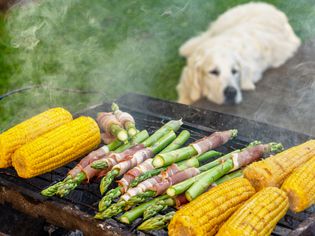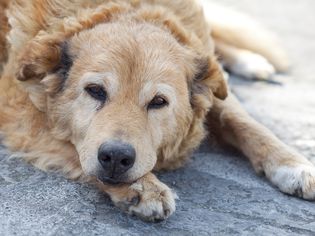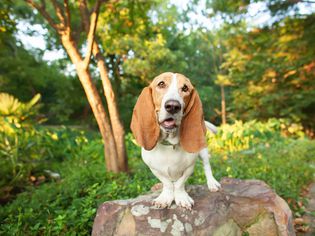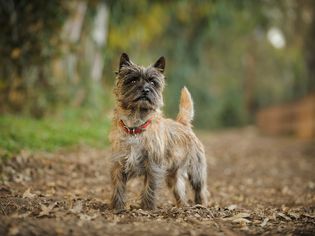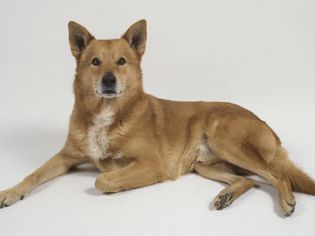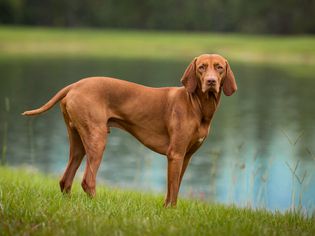The schnoodle is a cross between the schnauzer and poodle. Schnoodles have medium-length, curly, dense fur and appear in various colors. Schnoodles can come in three different sizes: miniature, standard, and giant. This loving and loyal breed is known for their affectionate nature, high intelligence, and teddy bear-like appearance. Although no breed is truly hypoallergenic, schnoodles are an excellent option for allergy sufferers, as both schnauzers and poodles are considered to be low-shedding breeds.
We spoke with three vets to learn more about the schnoodle, including their care needs, temperament, history, and how to find an ethical breeder or rescue.
Breed Overview
GROUP: Hybrid
HEIGHT: Up to 26 inches (standard)
WEIGHT: 10 pounds (miniature); up to 60 pounds (standard); up to 80 pounds (giant)
COAT: curly, medium
COAT COLOR: apricot, black, copper, cream, gray, golden, red, sable, white
LIFE SPAN: 12 to 15 years
TEMPERAMENT: Friendly, loyal, intelligent, energetic, lively
HYPOALLERGENIC: Yes, to a degree
ORIGIN: United States
Characteristics of the Schnoodle
Schnoodles are amazing companions with a cheerful temperament, love for playtime, and devotedness to their family. They can be vocal and protective, making for great watchdogs. The schnoodle is also brainy and athletic. You can expect them to be up for any activity, as they love nothing more than to be by your side and doing what they love—putting their mind and body to work.
| Affection Level | High |
| Friendliness | High |
| Kid-Friendly | High |
| Pet-Friendly | High |
| Exercise Needs | High |
| Playfulness | High |
| Energy Level | High |
| Trainability | High |
| Intelligence | High |
| Tendency to Bark | Medium |
| Amount of Shedding | Low |
History of the Schnoodle
The exact origins of the Schnoodle are unknown. However, the breed is considered to be fairly new, as it’s said that schnoodles were developed in the 1980s when poodle and doodle popularity skyrocketed.
This hybrid breed is not recognized by the American Kennel Club (AKC).
Schnoodle Care
With schnauzer and poodle parents, it comes as no surprise that the schnoodle is a naturally bright and active dog that requires frequent grooming.
"Potential pet parents should consider the schnoodle's need for regular grooming due to their curly coat, their high energy levels requiring daily exercise and mental stimulation, and their potential for separation anxiety if left alone for long periods," Robert Gonzales, DVM, says.
Exercise
Schnoodles are generally energetic and playful dogs, Sabrina Kong, DVM, says. To stay happy and healthy, she recommends they exercise for 45-60 minutes daily. This can be broken up into two or more sessions throughout the day.
A few activities that schnoodles typically enjoy include:
- Brisk walks
- Playing fetch
- Agility training
- Interactive games
"Regular exercise keeps them fit and helps curb any potential behavioral issues that may arise from boredom or excess energy," Kong says.
Not only aresSchnoodles highly active, but they're incredibly intelligent, too. For this reason, Kong says keeping a schnoodle mentally stimulated is "crucial."
She says a few great ways to keep your schnoodle busy and entertained include:
- Providing them with puzzle toys and treat dispenser toys to engage their problem-solving skills.
- Teaching them new tricks and commands to provide mental stimulation and strengthen your bond with your pet.
- Regularly changing out their toys and introducing new ones to keep their interest piqued.
- Providing opportunities for interactive playtime, like hide-and-seek games or scent work where they have to find hidden treats, for a rewarding and stimulating experience.
Grooming
Prepare to become BFFs with your dog's slicker brush—and a professional groomer. A schnoodles' fur can grow long and is quite curly and dense. So, although they don't shed much, they do require regular grooming, Bethany Hsia, DVM, says. This helps maintain their coat's health, appearance, and manageability, she adds.
"Typically, they should be groomed every 4–6 weeks to keep their coats in good condition," Kong says. "Regular grooming includes brushing several times a week to prevent matting and tangling, especially if their coat is more like a poodle's."
During shedding seasons, your schnoodle may shed more and require additional brushing to manage their coat. Kong says these seasonal changes can influence their grooming needs. For example, you might opt for a shorter trim to keep your schnoodle cool and to manage shedding in the warmer months and leave their coat slightly long to provide extra warmth in the colder months.
Hsia recommends clipping your Schnoodle's nails every 3-4 weeks to prevent nail overgrowth, bathing them once a month or as needed using a gentle dog shampoo, and cleaning their ears weekly to maintain their ear health since they're prone to ear infections. And don't forget to brush their teeth daily, too.
Training
With two brainy parent breeds, Hsia says schnoodles generally inherit their trainability. Meaning, they're likely easy to train and eager-to-please compared to other breeds. However, Hsia says this can vary based on each individual dog.
"Some may display a more independent or stubborn streak, which could make training more challenging," she notes.
When it comes to training a schnoodle, Kong recommends they begin as early as possible, ideally when they're still puppies around 8-10 weeks old. With early socialization and basic obedience training, puppies can develop good behavior and manners.
"Starting training at a young age helps establish a strong foundation and makes teaching more advanced commands and tricks easier as they grow," Kong explains. "Positive reinforcement methods, such as treats and praise, are particularly effective with schnoodles due to their eager-to-please nature."
Common Health Problems
Like all dog breeds, schnoodles may be prone to certain health conditions. And being a hybrid breed, they can be susceptible to hereditary health problems commonly seen in both schnauzers and poodles, including:
- Hip dysplasia
- Progressive retinal atrophy (PRA)
- Cataracts
- Skin conditions
- Patellar luxation
- Allergies
- Ear infections (especially if their ears aren't kept clean and dry)
"Regular veterinary check-ups, a balanced diet, and an appropriate exercise routine can help manage and prevent many of these health issues," Kong says. "It is fundamental to be proactive about their health and monitor for any signs of discomfort or unusual behavior."
Diet and Nutrition
A schnoodle's daily diet should consist of high-quality dog food that's appropriate for their age, size, and activity level, Kong says. A complete and balanced dog food that meets the nutritional standards established by the Association of American Feed Control Officials (AAFCO) will provide your pooch with all the necessary nutrients for optimal health.
"Depending on the specific needs of the individual dog, you may choose between dry kibble, wet food, or a combination of both," Kong says. Consult your vet for specific food and feeding recommendations based on your dog's individual needs.
It's also important to make sure your dog has access to fresh, clean water at all times.
Where to Adopt or Buy a Schnoodle
The craze for designer doodle dogs like the schnoodle has led to a massive and unfortunate problem—an abundance of backyard breeders and puppy mills.
If you're considering purchasing a schnoodle, expect to pay anywhere from $2,500 to $5,000 from a reputable breeder. The general cost to adopt a schnoodle is about $300 but can vary.
For further information to help you find a schnoodle, check out:
- Adopt a Pet
- California Doodle Rescue
- Petfinder
It's always a good idea to check local animal shelters and rescue groups to see if there's a schnoodle in need of a home near you.
Schnoodle Overview
Schnoodles are sweet, expressive, and playful dogs with low-shedding coats. They make wonderful family pets and are devoted to their people. This breed requires daily physical activity and mental stimulation to stay happy and healthy. Depending on which traits they inherit, schnoodles can have a tendency to bark or find ways to entertain themselves with inappropriate, destructive behaviors if bored.
Pros of the Schnoodle
- Intelligent and easy to train
- Low-shedding coat that can be a good option for people with allergies
- Loving demeanor and tend to love their family
Cons of the Schnoodle
- Prefers not to be left alone
- Requires frequent grooming
- May bark or engage in destructive behavior if bored
More Dog Breeds and Further Research
As with any breed, make sure to do plenty of research to learn whether the schnoodle is the right breed for you before deciding to bring one home. Talk with schnoodle owners, reputable breeders, rescue groups, and veterinary professionals for more information.
If you're interested in similar breeds, check out:
- Bichon frise
- Cavapoo
- Miniature pinscher
There’s a whole world of potential dog breeds out there—with a little research, you can find the right one to bring home.
- Are schnoodles good dogs?
Yes! Schnoodles are affectionate, playful, and devoted companions. With early socialization and training, they can make wonderful family dogs and get along with all humans and pets alike.
Are schnoodles high maintenance?Because of their active and intelligent parent breeds, schnoodles need sufficient, daily exercise and enrichment to be at their best. And although they're a low-shedding breed, they require frequent grooming to prevent tangles and matting.
Do schnoodles bark a lot?While no schnoodle is the same, some schnoodles may bark a lot due to both the schnauzer and poodle's high tendency to be vocal. With early consistent training, this breed can learn when barking is appropriate.

